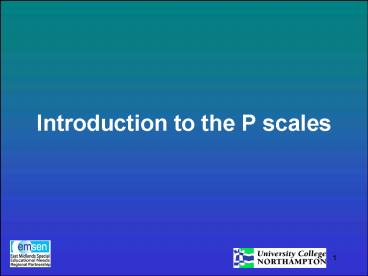Introduction to the P scales - PowerPoint PPT Presentation
1 / 19
Title:
Introduction to the P scales
Description:
Only to be used pre 5 years as an addition to the Foundation Stage Profile, if ... Exemplification and moderation processes give opportunities for discussion about ... – PowerPoint PPT presentation
Number of Views:120
Avg rating:3.0/5.0
Title: Introduction to the P scales
1
Introduction to the P scales
2
Supporting the target setting process Guidance
for effective target setting for pupils with
special educational needs (1998 DfEE)
- P levels 1 8
- language and literacy, mathematics, personal and
social development - Sub-levels within levels 1 and 2 of national
curriculum - P 1-3 generic early development
3
Publication
- DfEE
- Supporting the target setting process (1998 )
- Supporting the target setting process
- (revised March 2001)
4
Publications
- QCA
- Planning, teaching and assessing the curriculum
for pupils with learning difficulties (2001)
5
1st revisions of the P Scales (2001)
- P1-3 subdivided
- P1(i) P1(ii) P2(i) P2(ii) P3(i) P3(ii)
- P1-3 generic
- with examples illustrating generic attainment
within the context of each subject - P4-P8 subject specific
- PSD withdrawn (although still used by many
schools)
6
Latest P scale revisions
- Obtained from the QCA website
- P1 P3 no change
- Reviewed descriptions P4 - P8 in English, Maths,
Science and ICT - English Speaking and Listening comprehension
and expression strands split - Level 1 2 slight amendments
- Access from www.qca.org.uk/ages3-14/inclusion/7606
.html
7
Documents
- Removing Barriers to Achievement
- The Governments Strategy for SEN
- DfES/0117/2004
- DfES/0104/2004 - Executive Summary
8
Removing Barriers to Achievement The
Governments Strategy for SEN
- Items related to P scales
- Not enough information about pupils not entered
for national tests - Government will promote and extend the use of P
scales - P scale information will be included in PAT and
PANDA to help make meaningful comparisons
9
Documents
- Setting targets for pupils with special
educational needs - Ofsted - Ref HMI 751 February 2004
10
OFSTED report - recommendations
- LEAs
- Include pupils with SEN in the overall LEA system
for collating and analysing pupil attainment and
achievement data - Increase expertise in target setting and data
analysis for pupils with SEN, to support school
self review process - Provide training
11
OFSTED report recommendations - continued
- Schools
- Incorporate assessment and recording arrangements
for pupils with SEN into whole-school
arrangements for all pupils - Develop expertise in setting targets and
monitoring progress of low attaining pupils
12
Links to the Foundation Stage
- The Foundation Stage Profile describes attainment
between the ages of 3 -5 years - The P scales were designed for pupils from Key
Stage 1 upwards who were working below Level 1 of
the National Curriculum - QCA recommend that pupils aged 3 -5 years should
not routinely be assessed using P scales
13
Uses of P levels
- Summative assessments
- Best fit professional judgement over period of
time - Linear progress
- Lateral progress
- Target setting
14
P scales were designed for
- Supporting the target setting process
- Data collection from summer 2005
- Pupils aged 5 -16 years
- Using at the end of Key Stages- or more
frequently if the pupil makes substantial
progress - Only to be used pre 5 years as an addition to the
Foundation Stage Profile, if the pupil has
significant learning difficulties and/or a
Statement of Special Educational needs - Post 16 years , P scales not obligatory schools
encouraged to consult The adult pre-entry
curriculum framework for literacy and numeracy
15
P scales are not.
- An alternative curriculum
- A test or curriculum that teachers are encouraged
to teach to - A replacement of effective existing assessment
frameworks - A system only relevant for special schools
16
Inclusive benefits
- Recognises attainment below level 1
- Shared focus/language across all school settings
- Can highlight progress for individual children
- Can provides a database for school target setting
- Exemplification and moderation processes give
opportunities for discussion about teaching,
learning and assessment
17
Issues for Inclusion
- Provides a system that shows progress and
achievement across whole school population - Links National Curriculum Literacy and Numeracy
strategies - Provides information to show value added
- Provides information to support whole school,
cohort and individual target setting - Provides parents with a detailed measure of their
childs progress
18
Looking to the future Risks
- P scales used for inappropriate purposes
- P scales become the curriculum for learners
working below NC levels, rather than a longer
term target setting / review resource - Insufficient attention given to other resources
and their quality control PIVATS, B Squared,
PACE etc
19
Looking to the future Opportunities
- Teacher assessment raised in status through the
development of moderation schemes - Partnerships between special and mainstream
agencies flourish because of the development of a
common language - Strong and supportive use of the scales as
systems of review strengthen curricula and build
learning opportunities for all.































